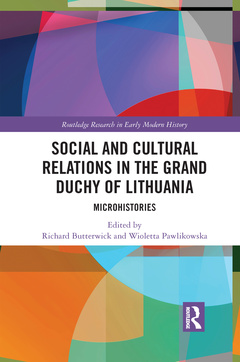Description
Social and Cultural Relations in the Grand Duchy of Lithuania
Microhistories
Routledge Research in Early Modern History Series
Coordinators: Butterwick Richard, Pawlikowska Wioletta
Language: English
Keywords
Par Ma; ESRI ArcGIS Software; National Library; Great Famine; Grand Duchy; Teutonic Order; Kalwaria Zebrzydowska; Grand Hetman; Lithuanian Noble; Lithuanian Academy; Lithuanian Army; Treasury Commission; Unfree People; Unfree Servants; Miraculous Image; Polish Coat; Surety Bonds; Treasury Administration; Unfree Woman; Fire Lustrations; Grand Duke Gediminas; Double Eagle; Unfree Person; Reformation Movement; Tomas Venclova
Publication date: 06-2021
· 15.2x22.9 cm · Paperback
Publication date: 04-2019
· 15.2x22.9 cm · Hardback
Description
/li>Contents
/li>Readership
/li>Biography
/li>
The Grand Duchy of Lithuania was one of the largest and most linguistically, ethnically and religiously diverse polities in late medieval and early modern Europe. In the mid-1380s the Grand Duchy of Lithuania entered into a long process of union with the Kingdom of Poland. Since the destruction of the Polish-Lithuanian Commonwealth in 1795, the history and memory of the Grand Duchy of Lithuania have been much contested among its successor nations. This volume aims to excavate a level below their largely incompatible narratives. Instead, in an encounter with freshly discovered or long neglected sources, the authors of this book seek new understanding of the Grand Duchy, its citizens and inhabitants in "microhistories." Emphasizing urban and rural spaces, families, communities, networks, and travels, this book presents fresh research by established and emerging scholars.
Introduction Part I: Urban Spaces and Communities 1. What’s in a Name?: Conflict and the Common Weal, Unity and Diversity in the Early Modern City 2. A History of One House: The Microcosm of the Jurydyka of the Vilna Cathedral Chapter in the Sixteenth and Early Seventeenth Centuries 3. The Poor and the Community: The Lutheran Charitable System in Eighteenth-Century Wilna 4. A Town After a Fire: Losses and Behaviour of Jewish Communities 5. The Attempts of the Bernardines to Influence the Society of Kowno in the Second Half of the Seventeenth Century: The Case of a Miraculous Image Part II: Families and Networks 6. Noble Names: Changes in Lithuanian Aristocratic Name-Giving during the Late Fourteenth and Fifteenth Centuries 7. The Sphragistics and Heraldry of Three Representatives of the Radziwiłł Family8. Noblemen’s Familia: The Life of Unfree People on Manors in the Sixteenth Century and the First Half of the Seventeenth Century 9. Noble Community and Local Politics in the Wiłkomierz District During the Reign of Sigismund Vasa (1587–1632) 10. From Clientage Structure to a New Social Group: The Formation of the Group of Public Servants in the Grand Duchy of Lithuania in the Late Eighteenth Century Part III: Texts and Travels 11. "An Earnest Gospeller" and "a Dignified Martyr": Networks of Textual Exchange between the Grand Duchy of Lithuania and England, 1560s-1580s 12. Terrible Reality?: Cannibalism in the Grand Duchy of Lithuania and in Livonia in the Sixteenth to Eighteenth Centuries – Between Chroniclers’ Invective and the Findings of Cultural Anthropology 13. A Lithuanian Nobleman’s Mapping of Poland: The Itinerary of a Peregrination by Stanisław Samuel Szemiot (1680) 14. Propaganda in the Parishes: Local Communication During the Insurrection of 1794 15. The Route Map of Dean Szymon Waraxa’s Courier
Richard Butterwick is Professor of Polish-Lithuanian History at UCL-SSEES and holds the European Civilization Chair at the College of Europe, Natolin, Warsaw.
Wioletta Pawlikowska is Researcher at the Tadeusz Manteuffel Institute of History of the Polish Academy of Sciences in Warsaw.




